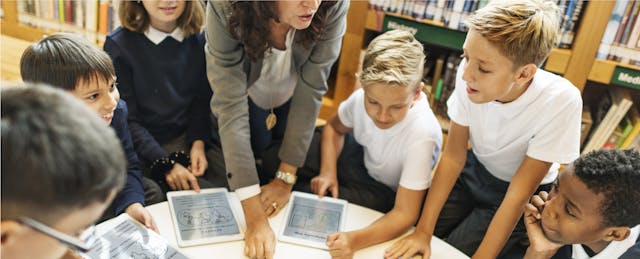I often hear people question whether teachers are willing to embrace technology, but if we really want to transform teaching and learning, I think the better question is, “Are we willing to change our expectations for how and what students learn?”
If we only focus on the latest programs, makerspaces or the devices rather than on creating powerful learning experiences that align with the type of skills and character traits we want students to develop, we will continue to perpetuate the same norms in education with more expensive tools.
To explain the difference between adding technology and powerful teaching and learning, I want to share examples of three different types of classrooms I’ve visited recently.
Classroom 1
In this first classroom, the teacher is calling on her 5th graders one-by-one to identify each state and its geographic location. When I talked to one of the students, she told me that they were learning the states by copying them from an atlas onto a map packet because “the teacher thought it was important to know them.” I asked if she knew a better way to learn about the states.
She pointed to the iPad face down on her desk and queried, “The internet?” Looking around the room, I noticed that every student had an iPad, and every iPad was face down on the desk.
Classroom 2
In the second type of classroom, each student had a device to log on to computer adaptive programs that individualize their learning path. Students learn content and practice a variety of basic skills while they move through various levels at their own pace. Although the students have devices, this lesson is basically a digital worksheet.
Some variation of the lessons is still happening in many twenty-first-century classrooms. The emphasis in both of these examples is on compliance and standardization rather than on deep, personal learning. They illustrate the challenge that exists in many classrooms when we add new resources and expectations to an old paradigm of school.
Classroom 3
In the third classroom, Kim Cawkwell co-created the learning experiences based on the learning objectives and students’ interests. They called it the Project Ideate. Her 4th-grade students engaged in a project during which they partnered with local businesses to understand their challenges and design solutions to impact their local community. Groups of students planned a pitch to present to a variety of businesses, including the local water board, the Humane Society, and a preschool.
They received authentic feedback and made revisions to address the needs of the business partners. While creating prototypes and revising their ideas, they developed and built on their problem-solving and critical-thinking skills. The technology in this class allowed all students access to relevant resources and to connect with people to learn, create, share and solve problems.
Through the design and launch of a website and videos for their business, they learned how to effectively communicate through various mediums to document and share their ideas. Students completed several types of self-assessments, curated their work and reflected on their learning connected to the desired learning goals to evaluate progress with their teachers and determine next steps. In addition to the standards, Sinqi, one of the students, told me, “I learned to keep persevering with your ideas and don’t give up on yourself.” This kind of lesson and the learning it provides goes way beyond engagement to empower students.
The Evolving Role of the Educator
Each of the three classrooms described above have ample technology and might be considered twenty-first-century classrooms—if technology was the only qualification. But the learning experiences designed in each room is developing three very different types of learners, workers and citizens.
Technology and access to information aren’t the most important factors in creating twenty-first-century classroom; teachers are. The power of the teacher comes not the information she shares but from the opportunities she creates for students to learn how to learn, solve problems, and apply learning in meaningful ways. Like Kim, educators around the world inspire their students (and me, for that matter) as they adeptly navigate their evolving role to meet the needs of those in their schools and classrooms.


